Raph Koster's Blog, page 21
February 15, 2013
Why do we like a given game?


I was just asked this on Quora, and thought I would crosspost my answer here.
What makes people like specific genres of gaming (FPS, strategy, sports, racing etc)?
What can you tell about people who like only a certain genre of gaming like Fps rather than strategy?
Everyone starts out with different natural predispositions. For example, some people are born with more fast-twitch fibers in their muscles, which gives them the ability to move more explosively than others [Skeletal striated muscle]. Other folks have greater color sensitivity, faster reaction times, better ability to see things that are moving or that are standing still.
Some of these things are spread across a gradient where a person may fall anywhere on the gradient, but there are biases based on the sex of the individual in question. [Men and Women Really Do See Things Differently] We should be cautious about treating this as “biology is destiny” and instead think in terms of statistical distribution; recent metastudies show that overall, sex differences in cognition are weak correlations [Science Confirms The Obvious: Men And Women Aren't That Different] but there are nonetheless some large and obvious differences between sexes and of course between people.
These predispositions mean that some things are easier or harder for a given individual. Not necessarily hugely so — maybe only marginally, say 1% easier than the norm. But it doesn’t matter, because of how the brain’s reward system works.
Dopamine is a hormone tightly linked with the learning process and with specific kinds of pleasure. It’s dangerous to generalize too much or ascribe it with too much power [The unsexy truth about dopamine], but in short, dopamine release is pleasurable and seems to be linked with the anticipation of a solution to a cognitive puzzle. Our brain works by attempting to assemble heuristics, habits, and schemata [Schema (psychology)] to be applied towards fresh and novel situations as we encounter them. We cluster together knowledge into groups we call “chunks” in order to better manage them with our relatively limited bandwidth. In other words, we function through pattern recognition.
Once we find a winning approach, we tend to repeat it. If we encounter a situation where we cannot apply any previously known pattern, then we are baffled. We need a “handle” to approach the problem with. In this sense, to quote myself “noise is just a name for patterns we don’t understand.” [A Theory of Fun for Game Design]
People with predispositions are therefore more likely to have a handle on patterns that lend themselves towards their particular skillset, because they were able to apply an inborn talent early. Someone with fast twitch muscle fibers in their legs learned that they can sprint fast pretty young. People with fine pitch perception learned that they can learn melodies easily. They got positive reinforcement from peers (“wow you’re fast!”, “you are musically talented!”) and also got self-reinforcement from their brain’s own learning mechanism. They applied a slight advantage to their schemata-building early on and were able to start practicing against a given problem set early.
Practice is what really makes the difference, particularly deliberate practice [Expertise], throwing yourself at the edge of your pattern library with conscious effort to push the boundaries out. This is hard work, and though just about any individual (barring actual disabilities) can do it for absolutely any field, it should be clear that people who had a leg up for a given field will experience less “noise” when they get going with the basics, will get more positive feedback on the way, and will likely seem to “be more talented” when in fact they are leveraging a statistically slight advantage. Think of it like compound interest, and you won’t be far wrong. Your own brain’s reward mechanism tends to push you to apply the known pattern, and so more and more you double-down on what worked in the past and keep practicing it.
To speak informally, it sucks to hammer away at something you feel bad at, and it feels good to hammer away at something you feel good at. And odds are excellent that you get external validation from every success at something you seem to be good at.
Games are in many ways deliberate practice machines (again, citing myself) [A Theory of Fun 10 Years Later]. We use them for recreation, but they are fundamentally and inevitably teaching us pattern recognition, habits, heuristics, and modes of thought. They are deliberately and consciously constructed to do so by game designers.
Different genres of game present different problem types [GDCA: Games Are Math slides posted]. These often cluster around specific things such as estimation of trajectory, odds calculation, solving NP-hard problems, and so on. People will come to these different games and different problem types with their existing pattern libraries, and therefore have “built in” skills in dealing with one type of game versus another.
If your skill set is poor, then you will find the game hard, or too hard. If you have plenty of reference context, you will find it approachable or easy. And this includes things like cultural context, rote learning (e.g., in a racing game, understanding what the torque ratings mean on different cars), affinity for narrative versus abstraction, etc.
All this boils down to “people tend to prefer the games that they are good at.” Often to the degree where they will play the game merely to exercise mastery, or as a form of meditation, rather than in order to actually engage in practice and push their skills even higher. It results in pleasurable feedback from the brain.
But. This same chain of logic argues that if you want to expand your skill set, your pattern library, your heuristics, your chunks — basically, if you want to maximize your potential — you should go play the games you don’t find fun. It will be hard work until you get a handle on them, but odds are good you have been avoiding these games because they are more work. And this carries through to life in general. You may think that you’re good at math and bad at poetry, and therefore avoid poetry as early as you can in life. But someday you may encounter a situation where the poetry is useful. Don’t avoid the things you find hard. Work on them.
In the end, though, you have limited time and can’t achieve mastery of everything. It isn’t surprising that the overall drivers here lead towards individuals specializing. We are a tribal species, and specialization drives interdependence. In the end, you have to decide for yourself whether you follow the Heinlein quote and the ideal of the Renaissance or well-rounded person [Heinlein - Specialization is for Insects] or whether you believe it is better to work towards utter expertise at one thing, and avoid cluttering your brain with the other stuff.
February 13, 2013
Color Theory of Fun images


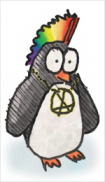 So, I have been working on the process to color all the cartoons in the revised Theory of Fun edition. I thought I might share some samples of the way it is looking so far.
So, I have been working on the process to color all the cartoons in the revised Theory of Fun edition. I thought I might share some samples of the way it is looking so far.
The original cartoons were done very quickly, which is why they were in such a rough, naif sort of style. They were also done with ink on paper, rather than digitally. I am trying to have the coloring be in keeping with that… I want something that feels fairly organic, even though I am doing all the coloring on the computer.
So I tried out doing plain flat shading, and gradients, and that sort of thing… but ended up using a custom brush to get a bit more of a painted look with more color variation.
In the process, I am also replacing the Comic Sans with my own handwriting font, like I used in the 10 Years Later presentation.
There are well over a hundred of these to do, of course. I am on pace to do multiple a day right now, although the flu has gotten in the way a bit.
In other news, though, the contract still isn’t finalized, so I am a bit ahead of myself anyway.  But that’s OK.
But that’s OK.
See a before and after comparison:
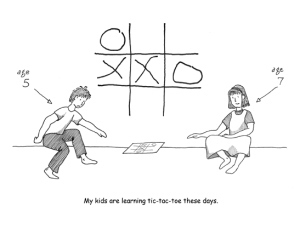
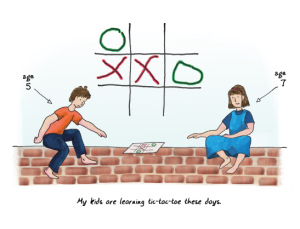 So here’s the first cartoon from the book. The one thing that I haven’t settled just yet is whether everything will indeed be this saturated, in the end, or whether I’ll lighten everything up and give it a softer, more pastel look. I suspect that I’ll get a better sense of that as I progress through more of the images.
So here’s the first cartoon from the book. The one thing that I haven’t settled just yet is whether everything will indeed be this saturated, in the end, or whether I’ll lighten everything up and give it a softer, more pastel look. I suspect that I’ll get a better sense of that as I progress through more of the images.
February 10, 2013
The Sunday Song: Freedom

I put this together today. I think it’s going to end up as the guitar part for a song with lyrics, but I liked it enough as a guitar part that I’m posting it up as just an instrumental. Nothing fancy here — I recorded it with a single mic, did a tiny bit of reverb and EQ, and left it at that.
It’s a capo monster — standard tuning, but capo’d at the second fret, and then again with a partial capo at the 6th fret, covering only strings 3, 4, and 5. I use a Kyser short-cut capo for this. You could use just a single partial capo at the 4th fret to play it a full step lower, of course, which would move it from the key of F# major down to E.
Download audio file (Freedom.mp3)
– download Freedom.mp3
Other than that, it’s all in the picking pattern. The trick here is that you finger less than it seems — almost all the chords are only two finger stops. The rising part is actually played in between the two capos.
January 12, 2013
Update #1 on revised Theory of Fun


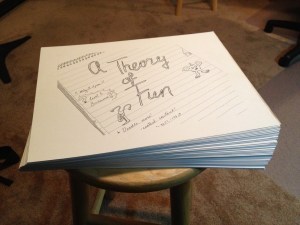 So, the revised edition of A Theory of Fun is indeed in process. I thought I would post an update for everyone.
So, the revised edition of A Theory of Fun is indeed in process. I thought I would post an update for everyone.
Where we are
I have been going back and forth with the publisher on what exactly needs to be revised. I have my own list, and I was hoping that the revisions would be shaped by responses from people as to things they disagreed with or have changed over time. I haven’t gotten a lot of those, alas… many thanks to those who have sent in stuff!
The reason this matters now, before any writing actually starts, is in order to set schedules for milestones. That said, I fully expect the coloring of all the artwork to take far longer than the text revision.
One thing that I have gotten as a vibe overall is “don’t break it.” Meaning, don’t change it too much or revise it to the point where it loses the qualities that make it what it is.
One big example of this that has come up and is still up in the air is the layout format of the book. As you know, it’s a non-standard trim size, wider than it is tall, and famously fits poorly on many bookshelves. I ran an informal poll on Twitter, and got very split results as to whether to change that. One of the biggest reasons in favor is that if it changes to a standard trim size, it cam move to print-on-demand in the book supply chain, and then it’ll tend to never fall out of print the way that it has in the past. Right now, when copies run out, the print run needs to be manually ordered. Plus, ebook versions mean that the layout aspect has already been somewhat lost. But a lot of folks seem to have great affection for what has been called “a bastard form of a picture book” … so we’ll see!
What’s done
Last weekend, I gathered up the final printed black and white cartoon images to look at what is involved in coloring them. They were all flattened, with the captions on them, in black and white. To color them, I really needed them to be transparent with line work, so I can paint behind them on another layer. The cartoons were in fact Photoshop files at one point (they all had the captions overlaid by me in Photoshop after all) but it looks like I cleared away the Photoshop files ages ago to save on disk space (many many gigs of it, back when gigs mattered) and I cannot locate a CD backup.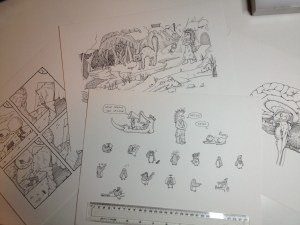
No worries — it took a few hours, but I got a Photoshop action done that takes the cartoons as printed, carefully grabs just the line work (with the grayscale and rough edges and the rest preserved, since it was all done by hand on Bristol board), and moves them onto a transparent layer. The old fashioned Magic Wand wouldn’t work, because I would lose the correct shape of the line. So now I have 5 gigabytes worth of cartoons ready to be colored.
For actually coloring, I hoped to do it on the iPad. Alas, there are no iPad apps that will open the PSD files. Photoshop Touch flattens them unless you use CS5 — I’m still on CS2! — and they fail to open on Sketchbook Pro and other apps. I would have done it on my old Tablet PC, except, well, the screen died. My old Wacom tablet has been obsolesced, and no longer even connects (serial port, ha!). Lastly, I have a Tablet PC for my job, but I can’t use company resources for this project.
So I have borrowed my daughter’s Bamboo tablet… and had to order a new pen for that, too, since she lost the first one. No sooner did I get it working than she took it back again… That said, I really miss not seeing what I am doing on the screen. (Hmm, those Windows Surface Pro tablets are coming out really soon…)
What’s next
The publisher and I should be agreeing on a schedule in the next week or so, and then I start coloring!
I also need to figure out what new material is going in the book — not so I can write it, but so that I can do cartoons for it. I am currently expecting to add a couple of pages within existing chapters, and if I do that, I am planning on doing those new cartoons in the same style, with the same tools, as last time. All in all, I expect there to be around the equivalent of 120 pages of cartoons to be colored, counting the new ones.
I also am going to take all the baked captions off of the cartoons, and replace them. We have hopes that perhaps some new translations will happen, and if so, it’ll make everyone’s life easier if the captions are not baked into the artwork. A while I ago I made some fonts of my handwriting that are similar to that in the cartoons (you can see those throughout the “10 Years Later” deck) and I will probably use those so that there is minimal change to the appearance of the cartoons.
In practice, only a couple of people have sent in the sort of detailed notes that I needed. If you want to help out, I could sure use the assistance still! Even small snippets or quibbles are enormously useful. I outlined what sort of thing I was looking for in the original post about it, but here’s a couple of anonymized examples of the stuff that people have sent in, so you can see what sort of help I am looking for.
Media violence note: I may be the 200th person to mention this, but you should include this study: http://www.international.ucla.edu/cms/files/dahl_dellaviga.pdf in the notes about the effects of media on violence. You may also want to address self-incapacitation and other ways in which violent media can reduce violent crime in the main text
or
If “Counter-Strike” is about teaching teamwork, why do people still play it after 5 years or more? What more teamwork – or indeed anything – is there to learn? Are they still having fun? If so, how does their kind of fun fit into your theory?
or
You talk about story in games as if it was all narrative arcs. There are different types of story, and the narrative arc is not the most important one: that’s the player’s OWN story, that they constructed from the events they experienced while playing through the game. A narrative arc is a way of pre-generating causal events that the designer feels the player will like, but it’s not the arc that’s important per se, it’s the experiencing of it through play.
January 4, 2013
UO Classic Postmortem video on GDCVault

Ultima Online is, of course, still very much alive. But that didn’t stop us from doing a Classic Game Postmortem at GDCOnline this past fall. The GDCVault has posted it up for free here:
GDC Vault – Classic Game Postmortem: Ultima Online.
No embed, alas.
The session was very informal — don’t expect a lot of actually useful development takeaways, five things that went well and five poorly in Gamasutra-approved format, any of that. Instead, it’s mostly war stories and anecdotes.
A thing you cannot see in the vid — when at the very start Starr asks how many people in the room worked on UO, a lot of people in the room stood up. And when asked who played — it was almost everyone. A nice moment.
December 21, 2012
Mailbag: High Seas

Raph,
You probably don’t remember me, but I played Metaplace a while back. We talked a lot about your ship game and you shared a link with me of the music you made. I cannot find that conversation!! Nor can I find the music on your site (unless I forgot what it was called). It was epic and I want to listen to it again.
Also, I know that Metaplace is no more but is the High Seas game out there anywhere to play for fun? If not, you should host it on your web server. It would be epic to play it again

- Crystal
I am tickled that anyone remembers either the game or the music! Especially given that we are coming up on the third anniversary of the closing of Metaplace.com… hard to believe it has been that long.
The music is called “The Knyghte’s Daliaunce,” as it was not originally meant as a pirate tune at all. I posted it up on the blog (with a chord chart) ages ago. It is also on the general Music page along with links to my album (it’s not on the album though). I really should record a new version of it sometime. Anyway, here you go:
Download audio file (knyghte.mp3)
– download link
The game is not available anywhere anymore, sorry! Yet another one of the dozens of games I have made that nobody can play. 
That said, there really was not much to it. Some simple boat movement code, firing sideways, and picking up on sailors when ships sank. It didn’t even keep track of score. For those who do not remember the game, it’s best captured in this YouTube video done by LunarRaid.
December 9, 2012
The Sunday Song: Zombie Christmas Trees

We chop the poor trees down, then stick them in embalming fluid to keep them alive for a few weeks while we use them as our helpless servants; then we throw them away to wither in a landfill. If that isn’t a zombie, what is?
This little ditty came about because of something my daughter said — I don’t remember what exactly. But she rolled her eyes a lot when I said that it gave me this idea. If you like, you can think of it as a spiritual sequel to “Dead Cheerleaders.”
Download audio file (ZombieChristmasTrees.mp3)
-download here
I just wrote this yesterday and recorded it in a few hours today. I play it up at Capo VII, fingerpicked, but in the recording I added a couple more guitars to give it body and it sort of turned into a 70s country rock song. Sorry about that. The fingerpicked line is on the Baby Taylor, and the rhythm parts are on the Blueridge, and I just doubled it through an amp simulator to get some crunch and space in it. And added a bass part and a fake Hammond organ.
Here’s the words and the chords, so you can sing it when caroling to freak out your neighbors. Extra points if they have a golden retriever. If you want to try the finger picked part, though, capo 7, and then you’ll have to transpose — it’ll start out with D C G chord shapes, basically.
Zombie Christmas Trees
A G D
If only you hadn’t built that Christmas Tree farm on top of the ancient burial ground
A G D
Because then we trees absorbed the evil in our sap
C G D
Now that Christmastime has once again come around
C G F D
You’ll come to our homes to chop us down and fall into our trap…!
A G D
We throw needles just like ninja stars to skewer you in the eye
A G D
We’ll set ourselves on fire just to make you fry – we’re very flammable you know
C G D
We wrap lights around in a cunning disguise and electrocute you blind
G F C C# D
And when all else fails we’ll spill our water so we turn brown and die and uglify–needles everywhere
C D C D
You keep us alive in little pots after you cut us off at the knees!
G Em F C D
We will have our revenge! We are the Zombie Christmas Trees!
We resent how you’ve ignored our lopsided brethren
And it’s humiliating to call him Charlie Brown when he’s just a very young specimen
What’s wrong with you? The conifers are such a noble species
We stay green just about all the time, and it’s not easy but it’s fine
Sometimes we take apprentices. I’ve seen poinsettias do terrible things.
And mistletoe harbor jealous resentment and vile murderous dreams
You don’t think the shape of wreaths is actually coincidence? Ha!
They’re meant to go around a human neck
Sure, pine deodorant’s in all your cars, but you say we make you sneeze?
We will have our revenge! We are the Zombie Christmas Trees!
Bm F#m
And sometimes we dream of eating Christmas cookies or sharing in the holiday meals
G F#7
Of opening presents and being family members — you don’t know how awful these futile daydreams feel
Bm F#m
But no, instead you stand us in a corner, our arms getting tired, until they SNAP!
G F#7 G7
And we share a special hatred for your dogs. We are not bathrooms or chew toys. Try the Yule logs.
C#dim D C# C D
Your golden retriever is DOOOOOOOOOMED! Doomed, doomed, doomed, Doomed heh heh heh
Cats, we can get along with. They like to climb in us. We coexist. It’s cool. & they secretly hate people too. (spoken)
We may meet ignominious ends, as our cadavers are set out to recycle.
But we are making plans that are both nefarious AND diabolical.
We gather at night in the landfills where you chip us into mulch
But in fact, your mulch is a spy! We have your floorplans!
Soon we will uproot ourselves and march to take you out
We will hang our war tinsel on our graceful boughs
And we will come for you, come for you pathetic humans
We would eat your brains if only we had mouths!
What makes you arrogant humans think that you can do as you please?
You keep us alive in little pots after you cut us off at the knees!
You start Christmas sales before Thanksgiving – puhleeeze
We will have our revenge! We are the Zombie Christmas Trees!
December 5, 2012
Help me revise A Theory of Fun!


 Next year will mark the tenth anniversary of the publication of A Theory of Fun as a book. The publisher is planning a second edition in full color!
Next year will mark the tenth anniversary of the publication of A Theory of Fun as a book. The publisher is planning a second edition in full color!
The contract isn’t signed just yet, because I owe them an outline for the revisions. Needless to say, I get to do revised text, and this is where I would like to ask for help. The book is so widely used by folks in the industry that I want to make sure that it has all of the right stuff in it — updated science, latest thinking on game cognition and learning, new thoughts on game ethics — all of it.
I would love to get more eyes on the problem. So if you’re up for it, I would love for as many people as possible to
(re)read the book – hey, it’s short!
make a note of everywhere you want to argue, and tell me where and why. I’ll argue back in the actual text (well, I’ll try to make my case better, how’s that).
make a note of any useful or cool references, science, news, or whatever that fits with what is already there. A lot has happened in ten years.
any errata? (I already know about the mistake in the drawing of the go board… anything else?)
I realize this is a huge favor… needless to say, anyone who helps will get acknowledged in the new edition.
Another thing that has come up occasionally is use of the book in a classroom setting. If anyone here has ideas on how to make it better for that use, I’d love to hear about those too. Are you an academic who has used the book in a classroom setting? Do you have study guide questions or discussion topics? I am currently unsure whether this sort of material would land in the book or on the website, but given how widely it’s used for this purpose, it seems like a great resource to make available.
Finally, there’s the possibility of adding other new stuff. I don’t want to try cramming game grammar into a single new chapter, but… if there were additional material of some sort in the book, like a whole new chapter, what would you want it to be?
Feel free to add whatever you can in the comment thread here, or to use the contact form to connect with me on this (I’m not going to post an email address here, to avoid spam, but if you use the form, I can email back).
I’m excited about this — though I do expect that most of my time will be spent coloring the cartoons. 
November 30, 2012
GDC China 2012 keynote: How Games Think

 I have finally gotten around to posting up the slides and the notes for my talk delivered in Shanghai just before Thanksgiving.
I have finally gotten around to posting up the slides and the notes for my talk delivered in Shanghai just before Thanksgiving.
The notes are actually pretty representative of the actual speech as delivered — we had real-time translation going on, so I kept the pace very deliberate and avoided my usual rattle-stuff-off-a-mile-a-minute sort of delivery. If you go to this link you can see the slides as individual images with the notes interspersed.
If that isn’t to your taste, and you want just the slides, you can find a PDF of the slides here instead.
Afterwards, one of the Chinese attendees came up to me and told me it had been “a faith-building talk.” I can only presume that the folks working in the industry in China have the same crises of faith that we do here in the West. 
There was some coverage in Chinese, I am sure, given that there were reporters there from a few sites. But the only article I’ve found from China is this one. However, Gamasutra was there, and wrote up an article.
While I was at it, I also updated the sadly neglected Presentations page in the Gaming section of the site. How many of you even know that there are a pile of pages reachable from the little links under the blog’s title? Anyway, I added all the missing presentations from the last two years. They were all mentioned here on the blog, of course, but now they are gathered there with their brethren. Just scroll to the bottom. A few of them have full video embedded.
November 13, 2012
Keynoting GDC China

I’ve been sadly neglectful of this blog! In the last few weeks, particularly, because I have been fighting off some sort of nasty flu thing… still have a lingering cough, in fact, and it’s been more than two weeks!
So that meant that while I was flat out in bed, I missed the official announcement about the talk I am giving at GDC China this weekend. It’s been years since I was in Shanghai, so I am looking forward to this!
As far as what the talk is about… well, it’s sort of an extension of the lines of thought from the Project Horseshoe talk Influences and the GDC Online talk It’s All Games Now, and even a little bit from the Theory of Fun 10 Years Later talk. Basically, it’s about the patterns of thinking that games tend to encourage… and how these ways of thinking may be affecting us culturally. After all, if games do their work in large part via neuroplasticity, then that means that the cognitive habits we are picking up as gamers must be having an impact on how we think about, well, everything.
What might those cognitive habits be? And what impact might that have?
It’s a keynote, and supposed to be “inspirational,” so it’s in a lot of ways a rather light treatment of the subject… but I think there’s a lot to dig into there, and not all of it is unalloyed good… instead, it will be a picture of trade-offs. For example, just recently I read an article on how the neural pathways for empathy and the neural pathways of logical thinking seem to be mutually exclusive; you can’t do both at the same time. You have to emotionally detach yourself to be able to do true systems analysis, but if you are conditioned to approach the world analytically, does this mean that you are conditioned to avoid empathy? Pure speculation, and of course the answer will not be clear-cut.
Anyway, here’s the details on the talk:
How Games Think
10:20-11:20 Sunday Nov. 18th
Raph Koster (Playdom/Disney Interactive)
Games change us. They change our brains, they change how we think.We live in a world where we have always been shaped culturally by literature, history, myth, art, and music. But now games are a dominant new medium. They bring with them ways of thinking. And that means that we, as humans, will literally think differently. We will see the world through the lens of games, and we will change the world using the tools of games.
It cuts both ways, because not all of the ways that games teach us to think are better — they are just different. And as a result, the world is changing in radical new ways.
In this talk, come learn how games think, and what that means for how we think, and what it means for our future.



